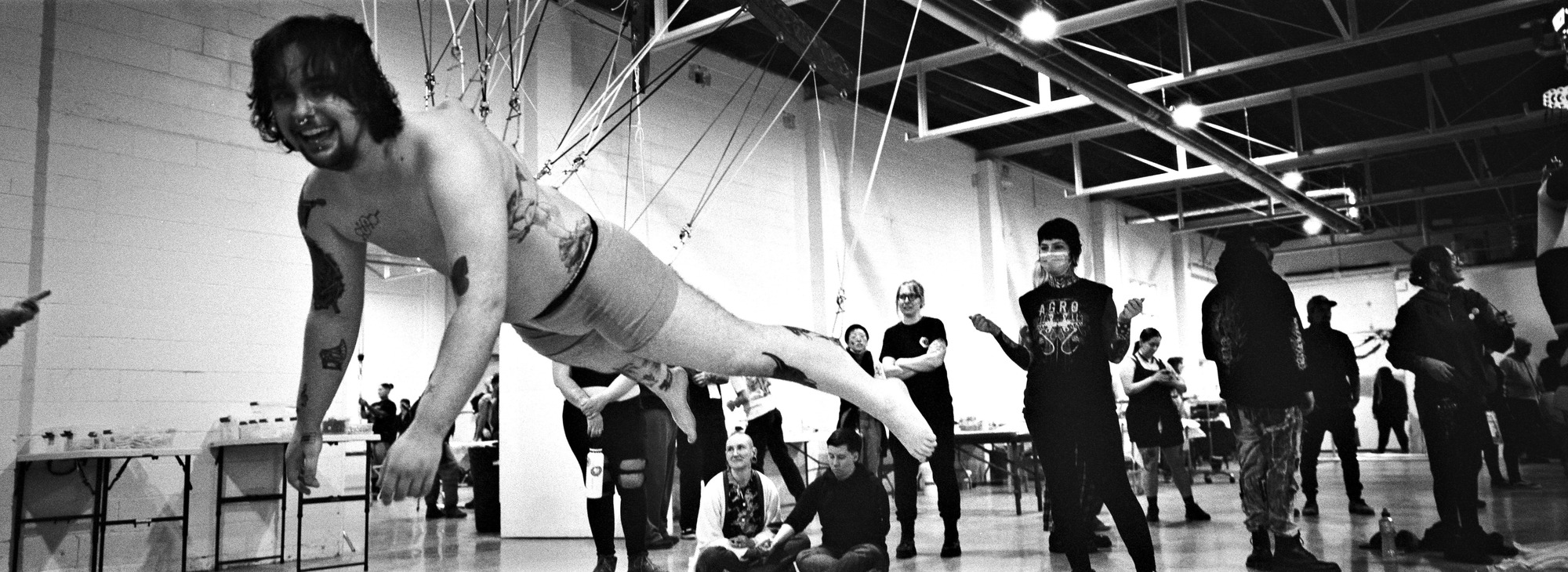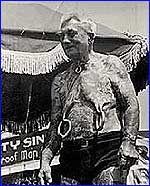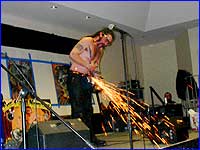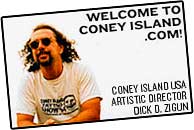 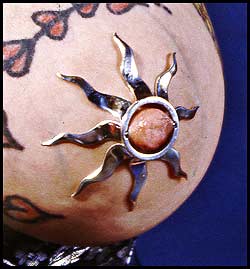 When Janet Jackson flashed her breast at the 2004 SuperBowl creating a firestorm of controversy, she was wearing a Gauntlet nipple shield. The sunburst design was one I created in the mid 70s. When you pay a visit to your local piercer and look at the tremendous variety of jewelry in their display case, it’s easy to assume it’s always been that way. What’s difficult to believe is that before Gauntlet, piercing enthusiasts were making do with earrings and all kinds of improvised contrivances. Although I’m always reluctant to blow my own horn, the truth is that I was personally responsible for many of the jewelry designs and piercing innovations most people take for granted.
Although Gauntlet officially became a business in November of 1975, it took nearly nine months before things began to come together enough for me to issue Gauntlet’s first jewelry “Folio.” To call it a catalog would be stretching things. It was simply a legal sized piece of heavy paper printed on both sides and folded into quarters. But to the best of my knowledge it was the first time any collection of body jewelry designs had ever been offered for sale to the public. Despite Doug’s financial help, my budget was still very lean. I had little knowledge of photography, especially taking pictures of jewelry, which is an art unto itself. Since I couldn’t afford to hire a professional photographer and printing photographs would have been more costly, I chose to illustrate the first brochure myself with line drawings. In these days of desktop publishing, younger people have no concept of what was involved to produce printed materials before the advent of the home computer. The process was in constant evolution, but in the mid 70s a common way was to take the copy to a local printer. There someone would type it into a special IBM Selectric typewriter — anyone remember typewriters? — equipped with memory. At the push of a button the text would then be printed onto special paper that would later be cut up and pasted by hand into the final layout. All very primitive by today’s standards. Headlines were often produced separately using fonts that were on a strip of film. Each letter was exposed onto light sensitive paper and when finished, processed in photo chemicals. As an alternative you could do as I did and use rubdown lettering for headlines. I was still groping my way. It took time to design and “test drive” the nearly dozen items that appeared in the first brochure. As mentioned in an earlier column, my first design was the nipple retainer. The bead ring, a scaled up version of a fairly common earring design, followed this. In the months and years to come, jewelry designs were always being developed and refined. Some became classics that are still being reproduced today; some were consigned almost immediately to history. Others lasted for a while, eventually fading into obscurity for lack of interest by customers. Still others ended up on the scrap heap because experience proved a particular design was no longer appropriate. Regardless of their longevity, many of them have an interesting story. For a great many years the standard bead ring with the attached ball was Gauntlet’s bread and butter. But some members of the T&P group, and others, wanted a design that appeared to be continuous. Had it been practical they would have been quite happy to have the rings permanently soldered shut. One of Gauntlet’s early competitors was a short-lived business called Whatever Rings. It was run by a couple of gay guys who were heavy S/M players. They operated out of their West Hollywood apartment and solicited business through ads in the local gay press. The business was primarily a means for them to entice men into an S/M scene. The “jewelry” sold by Whatever Rings consisted of gold wire formed into simple gold rings. There was no closure. While they might look nice, I personally considered them impractical if not dangerous. From experiments I had done I knew it was difficult to get the ends to line up perfectly, particularly after the ring had been inserted into a piercing. This could mean discomfort if the gap rotated inside the piercing. The gap, no matter how small, could also trap debris and quickly become a breeding ground for germs that could lead to infection in a fresh piercing. 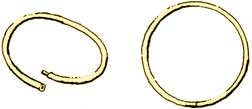 The “Seamless” Ring. Still, some people liked the look and insisted they wanted it. So I tried to make something at least a little more practical. I called it a “Seamless” Ring. It still had the small gap, but I perfected a way of crafting a pin coupling which, if nothing else would keep the ends in alignment. To minimize the risk of infection, I insisted that customers wait until their piercings had healed before wearing this type of jewelry. Unfortunately one of my customers discovered the shortcomings of the design not long after I’d inserted them into his nipple piercings. His name was Alden, and he was part of the T&P group. He also enjoyed rough sex play. Early one Monday morning he showed up on my doorstep. It was obvious something was wrong. Apparently he’d gotten into some pretty heavy action on Saturday night. Someone he was playing with got a little too rough with his nipple rings and one of them had sprung open inside the piercing. He couldn’t rotate the ring or remove it and was in great discomfort. I had to open the ring with a pair of ring expanding pliers in order to remove it. After that he understood the benefits of wearing a ring with a closure especially if he planned on a rough night. 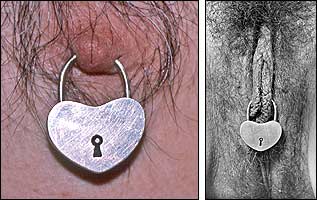 Handcrafted jewelry locks
The S/M B/D community were a significant component of my early clientele. A very common request was for a piece of jewelry that could be permanently installed. For most people this was nothing more than a fantasy. They still wanted something that could be removed whenever they wished it. So I set out to see what I could do with locks. Back when I’d lived in Denver I’d wanted to put a lock in my ear piercing. In the early 70s it was uncommon for a man to have an ear piercing at all, and stretched piercings were something you only saw in National Geographic. There was no way I could see to get a lock through my ear. I had some basic jewelry making tools and was easily able to get some silver sheet and wire. Using these I constructed a crude working lock. This design with its broken shackle and another with a solid one, made their way into my first jewelry brochure. Unfortunately these handcrafted locks were never practical. If worn on any semi-permanent basis, they would soon become bound up with disgusting gunk and nearly impossible to open. I attempted unsuccessfully to remedy the situation by replacing the tiny spring with a pad of silicone rubber. Making the locks became a job I dreaded. They involved a lot of work that seemed wasted because of the inherent problems. By the time I issued my second brochure I’d dropped the design with the broken shackle replacing it with a simulated lock that needed no key and had no mechanism to get fowled up. Eventually I discontinued locks altogether. 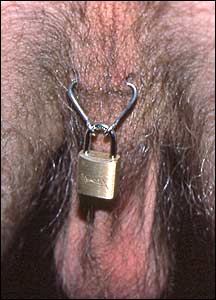 A jewelry prototype that never made it into production. Other attempts at permanently installable jewelry were made, such as a triangular ring that had two eyes, one threaded, that could be closed with a small lock. Since they weren’t waterproof, even commercially manufactured locks weren’t practical for long term wear. There were a few hardcore souls who seriously did want something permanent. Soldering, of course, was out of the question. I did find one successful solution. The balls on our standard bead ring were hollow. I would cut a groove around the end of the ring that went inside the ball and fill it with epoxy. When the ring was closed the cement would be forced into the groove where it would set and make the ring impossible to open. 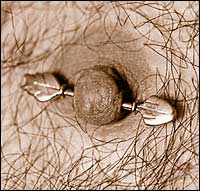 Arrow of Eros
I’ve written previously about the early development of barbells. Once I’d mastered the manufacturing problems it seemed natural to design some variations. The first was what I called the Arrow of Eros. To maximize comfort I didn’t want the head to be sharp, so I modified the shape to something like a Native American arrowhead. The two ends were forged out of metal. These were then taken to an engraver who cut the details. From there rubber molds were made so that the pieces could be cast. Though never a best selling design it nonetheless remained in the Gauntlet line for over twenty years.
Other barbell variations followed. The second brochure included what I called Jeweled Studs. These had semiprecious stone beads set in pronged pearl settings. They were never very popular and in time disappeared from the line. Over the years many other variations were introduced. None of them were ever as popular as the initial one with round balls which made it much more versatile. 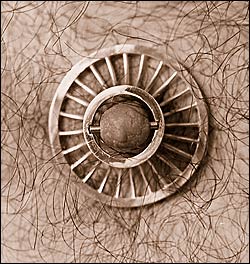 An early nipple shield design. To the best of my knowledge the concept of the nipple shield was original with Gauntlet. The idea was to offer a design that was more decorative and would appeal especially (though not exclusively) to women. As a gay man I still had a lot to learn about female anatomy because many of the first designs had an inside diameter that wouldn’t fit many female nipples! At one point I contemplated using spring-loaded watchband pins to hold the shields on, but this proved impractical and unnecessary. The tension of the stretched nipple was sufficient to hold the shield in place. S/M also had an influence especially on one particular design. Even in the early days there were people into play piercing. For them I came up with something like a spoked wheel which had a little more depth. This drew the nipple out so that hypodermic needles could be inserted through the spokes.  The septum retainer was a major breakthrough. (Left: the original septum retainer, right: niobium retainers) It might not exactly qualify as jewelry, but another early Gauntlet innovation was the septum retainer. You might be able to go to work with a septum piercing today, but in the 1970s it would have been unthinkable. Still, there were people who passionately wanted the piercing. That was my inspiration. The first septum retainers were made of oxidized copper wire covered with Teflon tubing. They were virtually invisible. Eventually they when replaced by an anodized niobium version which is offered by a number of manufacturers today. 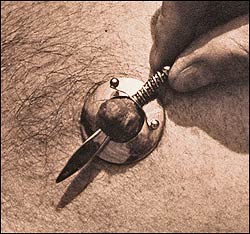 Custom nipple jewelry.
Especially in the early years when I made almost all the jewelry myself, I had a number of clients who asked me to create something custom just for them. One of the first was Jim A. He wanted a simple gold nipple shield that would be held in place by a gold sword. The blade was made from quarter inch tubing that was pounded flat on one end, soldered shut, and shaped. A brass plug was soldered into the other end. This was drilled and tapped. The handle was wrapped with wire and a bit of flattened chain and ornamented with gold balls. Jim stretched his piercings up to a quarter inch just so he could wear his new jewelry. 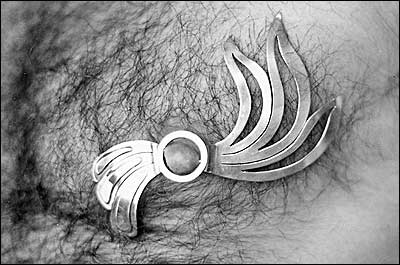 Another man wanted a custom nipple shield. He told me he had a thing for feathers and wanted this reflected in the design. It was something of a challenge. Not wanting it to be big or heavy, the feathers have large cutouts and are counterbalanced by complementary shapes that are weighted with extra metal. He seemed pleased. 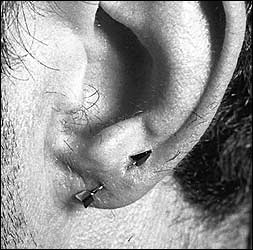 Multiple ear piercings weren’t exactly common in the early Gauntlet days. This man came in with two ear piercings and wanted an arrow made that would go through both of them. Here’s the result. The post was not straight but shaped to accommodate the piercings. The arrowhead was drilled and tapped to screw onto the post. It was so tiny that the only way I was able to screw it on was to use a pencil eraser with a slit cut in it to hold onto the arrowhead. One of my more colorful clients was a Hungarian doctor who showed up on my doorstep one day. I was still working out of the house at the time, and he’d been referred to me by the Pleasure Chest, a sex shop that had recently opened in West Hollywood. Dr. C was impeccably dressed in a suit and tie and had the bearing of a European gentleman. He explained that he wanted a frenum piercing. This was accomplished without a great deal of fuss. I must confess I was a bit more nervous that usual. Although clean, the house and furniture were shabby. He was, after all, a doctor, and I was concerned that he would be uncomfortable being pierced in such an environment. Still, I brought out a clean bath towel and spread it on the couch for him to lie on. I laid out the bagged and sterilized equipment on a stainless tray. When I was finished he complemented me my technique as well as the cleanliness that I observed. It was a particular validation coming from him. 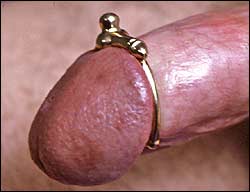 With casual European sophistication the good doctor told me that he and his wife were no longer sexually active. He had a young girlfriend who he particularly wanted to keep satisfied. To that end he commissioned me to make a cast gold frenum ring that would incorporate two penises and a ball on top that would stimulate her clitoris during intercourse. He quipped that he wanted to penetrate her with three penises. Dr. C was quite happy with the finished piece of jewelry. Unfortunately he didn’t feel comfortable wearing it all the time, especially at the health club. Consequently he took it on and off frequently. Eventually the post would break off, and he would bring it to me for repair. The last time this happened he brought it in and chatted amiably about what a wonderful device it was. I told him how long it would take for the repair, and everything seemed satisfactory. I never saw him again. Whatever happened to him I never found out. After holding onto the piece of jewelry for several years, I eventually sold it. 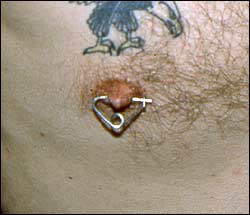 For the first several years all my jewelry was either gold or a mixture of gold and silver. Although many clients wanted stainless steel I didn’t know how to make jewelry from that particular metal. Early on I attempted a design I called a triangular safety pin made out of stainless steel wire. It was abandoned fairly quickly because the hook closure tended to snag on clothes and bedding. Gauntlet’s transition to stainless production was not an easy one. I resisted as long as possible and finally gave in because the price of gold had begun to rise alarmingly. The challenges were many. First and foremost it was necessary to determine which of the hundreds of stainless steel alloys was appropriate for inserting into the body. The best information I was able to gather was that it needed to be low-carbon and nickel-free. At various times we made jewelry of 304 and 316 stainless. The industry standard today is 316L. Then there was the matter of gauge. The standard gauge system used for steel wire is different from that used for gold and silver, so for the sake of consistency it was necessary to have all the stainless steel wire custom produced. The coils of wire arrived from the mill and I discovered that it was too stiff to be easily shaped. Gold and silver can be softened, a process called annealing, quite easily by heating them red hot and quenching them immediately in cold water. If you do this to steel you only make it harder. The only way to get the wire soft was to send it out and have it professionally heat-treated. At first I tried unsuccessfully to apply gold fabrication techniques to stainless steel. The results were disappointing to say the least. Eventually I found a company that was able to silver solder drilled stainless balls onto stainless steel rings and then electropolish them. For some reason the quality of the electropolishing was not reliable. Sometimes the surface was not mirror bright and on occasion the process was overdone and the rings came back measurably thinner than they should have been. Many of these problems could have been eliminated had I not been convinced that the captive bead ring design was unsatisfactory. As someone who continually thought of piercing as an adjunct to sex play, I felt the ball could too easily come loose and get lost. I couldn’t imagine many people wanting to search for a ball lost inside a body cavity. Stainless steel barbells presented their own difficulties. There was no way to produce them in house, so I went looking for a machinist to do the job for us. Part of the problem was that I had no idea how to locate the right person. The results were less than satisfactory. The first order of barbells I had made should never have seen the light of day much less been offered for sale. The machinist was unequipped to produce a stud with an internally threaded post. I ended up settling for externally threaded studs, and to say that I was frustrated is putting it mildly. In order to insert them without causing discomfort or damage to the individual, the externally threaded post first had to be dipped in melted wax. It was a compromise I hated. When the stock began running low I started looking for another machinist and finally found one who was able to produce an internally threaded barbell stud. Unfortunately that was only half the challenge. The other was to produce a ball with male thread attached. The machinist produced short threaded pins that had to be secured into drilled and threaded balls. We tried various kinds of cement without success and ended up having to silver solder them. It was a solution, although again less than 100% satisfactory. On occasion clients would ask why Gauntlet’s stainless steel jewelry was so expensive. I always told them that they could buy a nut and bolt at the hardware store for pennies because they were manufactured by the millions. At that time there simply weren’t enough people who needed stainless steel body jewelry to mass produce it like hardware. All that has certainly changed. 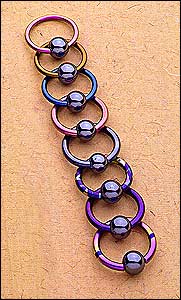 Niobium body jewelry, another Gauntlet innovation, is wildly popular today and available almost everywhere. In the early 80s craftspeople were beginning to make regular jewelry from anodized niobium. It was incredibly beautiful, and when I learned just how inert the metal was, I realized its great potential. The material was fairly inexpensive and could be anodized in an array of bright colors. It took some effort to perfect the technique. The anodizing process required that the metal piece be attached to an electrode and submerged in a solution mostly of water. The more oxygen the solution could make available to the process, the better the results. Different craftspeople had their own secret formulas. I heard of someone who used Coca-Cola. What seemed to work best for me was a solution containing non-chlorine bleach. Since there is no practical way to solder niobium, I finally was forced to embrace the captive bead ring. From then on it became part of Gauntlet’s jewelry line. It’s been almost thirty years since I started Gauntlet, but the ideas and innovations that it pioneered are very much with us today. I often wish I were receiving royalties. I’d be a very rich man. Next: The First Piercing Store Opens its Doors
Copyright © 2004 BMEzine.com LLC. Requests to publish full, edited, or shortened versions must be confirmed in writing. For bibliographical purposes this article was first published May 18th, 2004 by BMEzine.com LLC in Toronto, Ontario, Canada
|
 |
|||||||||||||||||
-
Gauntlet’s Jewelry Design Legacy [Running The Gauntlet – By Jim Ward]
Written by
-
Suspensions & Tensions: Today, Part II – Fakir Rants & Raves
Written by


Suspensions & Tensions:
Today, Part II
CONGRATULATIONS O-KEE-PA GRADUATES!In the past few months I’ve become aware that many others (photos, stories) beside me have tried and succeeded in being suspended vertically by two piercings in the chest — in essence, doing O-Kee-Pa the hard way.
I’ve seen your photos on the BME site. But I am not quite sure you had the depth of experience the Mandans (or I) had. Please tell me. I’ve sent feelers out to several suspension groups, but so far gotten no feedback. As the guy who kind of started all this in the first place (by example and photos) I truly feel responsible for what happens to you. I am very eager to hear from you if you have ever done an O-Kee-Pa style suspension. How long did you hang? Under what circumstances? Where did you go? What were the after effects? Please send Fakir an email about your experience.
Most of the suspensions I have facilitated and witnessed during the past thirty years resulted in unusual and often fantastic out-of-the-body adventures. One of the most interesting was that of a Catholic woman, Sharon C., who pleaded with me for several years to facilitate her suspension and be her shaman Ka-See-Ka guide/protector. Ten years ago, we made it happen. About seventy of us were gathered in Northern California at a place called Kenton Mine. We were there for two weeks so there was plenty of time to prepare for a special ritual. Since I had hung horizontally for long periods of time in years prior, we decided that a horizontal suspension by multiple piercings was the best way for Sharon to have the prolonged experience she desired. We wanted at least several hours up. Back then, none of us had ever heard of or tried doing this with modified fish hooks. That came several years later. So we settled on piercing the front side of her body with 22 long sterile piano wire loops as I had done several times.
On a sunny afternoon in a deep canyon filled with redwood trees, I pierced her body with the wires, bent them into loops and attached them to the frame I had devised for my own suspensions. The tribe assembled. We beat drums, burned sage, and chanted for beneficial spirits to guide Sharon on her journey. Slowly we inched her pierced body up off the mats on which it laid. Up under the branches of the thousand year old sacred Redwood Tree which seemed to murmur, “let me take this body to its source.” We were hushed and within several minutes, Sharon left her body. It was inanimate “meat” hanging high in the air beneath the branches of the tree.
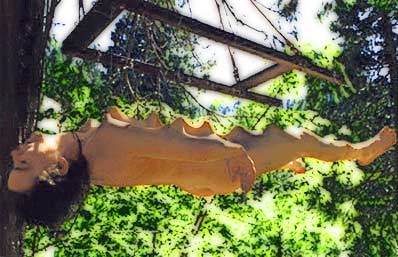
While suspended in a thousand year old redwood tree for several hours,Sharon C. went on a guided trip to her own private heaven and hell.
As the Ka-See-Ka who assumed responsibility for her journey, I was able to see what she saw in her disconnected state. First, she traveled to her private hell (a barren place with no signs of life) and them to her private heaven. I was able to communicate with her lifeless body, and, most unusual, she was able to speak through it! When lost in despair in her “hell” space, I suggested she turn around, look over her shoulder, and see what was behind her. There it was, her private heaven: a verdant forest filled with trees, birds, flowers, and fuzzy buffalos who smiled and wanted to play with her. I told Sharon she could fly and should go down and circle the forest below. She did and soon rested in a comfortable nest in the top of a tree. I told her she could go play with the animals below if she wanted.
“But they are smelly and dirty,” she said.
“That’s ok,” I told her. “You don’t have to step in their shit. You can fly now so just go down and fly above their heads.”
Sharon giggled and I saw her do this and tease the animals as she flew over them. There were many other odd adventures during her journey but finally, as she despaired for company, a luminous being who appeared as an animated blue infinity symbol, spoke to her and then buried itself deep in her heart center. It said to her, “Peace… Be Still”.
But this is not the end of the chapter and book for Sharon. The memory and lesson it held stayed with her to the end. Two years ago, Sharon developed ever worsening kidney failure. On dialysis, she felt the time had come to leave her body permanently. She called me. She was glowing, happy, radiant, as she announced her decision to disconnect from machines. She was not frightened of passing over into the unseen world. She had been there before. Sharon thanked me for my love and guidance. And she parted this world joyously.
JOURNEYS OF OTHER SEEKERS
Another dear friend of mine, Puma (see Body Play #9), had undergone a severe personal crisis in which he had been taken over by an extremely self-destructive (read suicidal) dark side, the “shadow side” which we all have. He went on barely functioning and seemingly headed for a bitter end. A year later, still troubled, he asked me to hang him up by two deep chest piercings. He pleaded to do the O-Kee-Pa seriously and privately so he could resolve this on-going power struggle with the negative energy that was controlling his life. This was to be an attempt to chase the “shadow” away once and for all.
In the absolute quiet of an indoor chamber, Puma was compelled to engage in a long and painful combat (his private hell) before he could let go and surrender; submit his mind and body to what was actually a “shamanic death”. He groaned and fought to stay in conscious control as I slowly inched his body upward against the chest piercings. When he finally let go, suspended, he appeared to be physically dead. His lover pleaded with me to let him down. But I saw Puma’s other electric body shape floating weightless and smiling at me from a remote corner of the room. He was ok. So I let his physical body hang motionless for another ten minutes.
When I finally let Puma’s lifeless form down, just as light flickered back into his eyes, I saw the “shadow” inside them screaming in agony. A voice behind these fiery eyes seemed to say, “If this is what you are going to do to me, I’ll leave!”
Woosh!
And within ten minutes the Puma we know and loved was back in those eyes — exhausted, happy and free. Characteristic of a truly transformative experience, the effect lingers on years later. Puma told me just a few days ago, “I’ll never forget what happened. This was a truly spiritual experience for me and I continue to draw strength from it every day.”

But not every suspension ends with such beneficial results as Sharon’s and Puma’s. Sometimes things go sour when our expectations or approach to the suspension is off-key. I have attended a bunch of these and that is why I am so fussy about having clear intent, inner guidance, and not being swayed by ego when I am advising or helping someone do a suspension. Several suspensions that went wrong come to mind as I write this column. The first was done several years ago by Idexa, the San Francisco tattoo artist. I asked her to write about her vertical suspension that went wrong for Body Play magazine. In her own words, here is what she wrote for Body Play #14:
My last trip on a spiritual path, in early 1995, consisted of borrowed and modified rituals of other cultures. I did a vertical suspension by flesh hooks. Raelyn Gallina did the piercing and suspended me by elastic cords.The original plan was to have a small private gathering. But it eventually became a huge event with about a hundred people, mainly women. It took place at night in a big building and in that setting I just couldn’t visualize enough to break through the ceiling and roof — where in past body rites trees and birds have helped me to travel. I liked the sensation of hooks going under my skin (except for the ones below my breasts). I loved stepping off the ladder to hang by my flesh. It was a wonderful challenge and a body high.
But with so many people around, and the scattered energy in such a limited space, I really didn’t get to have the visions I was hoping for. What I see today in many of these borrowed rituals is a lot of “white people” doing it as entertainment, even money, for a bunch of spectators. It (suspensions) being so popular, so obviously a “white thing” (non-traditional), has opened my eyes. I feel the movement is taking part in a continuing genocide of indigenous cultures that started here with Columbus.
Idexa
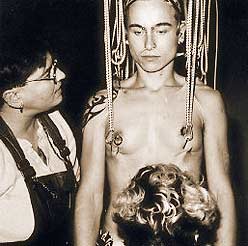
Above: Idexa is pierced and rigged for her vertical suspension by Raelyn Gallina.

Right: Idexa steps off short ladder and hangs freely, but her ability to journey is hindered by physical and psychic distractions.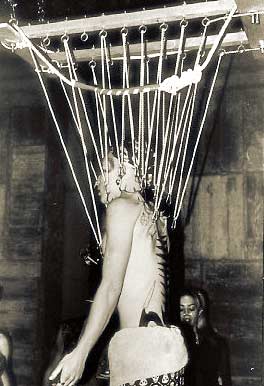
Another “sour” suspension I witnessed in the last few years was Paul Stolz’s first attempt to do an O-Kee-Pa. On previous occasions I had seen him do several horizontal suspensions facilitated by Vaughn of Body Manipulations. These were sweet — no problems (read the description that follows). But, apparently overcome with self-confidence by them, he decided it would be “no sweat” to hang by two piercings in the chest like I had done. He talked to me several weeks prior.
I warned that this would be different, many magnitudes harder and could not be done without surrendering ego. I told him that after about one minute he would have to go through all the symptoms of drowning or suffocating. Was he ready for that? I asked if he wanted me to “Ka-See-Ka” him. “No, just come and witness,” he said.
So that’s what I did. No rescue offered.
The suspension got off to a good start. Joey Wyman did an expert, shamanic job of piercing two hooks in Paul’s chest, deep and just above the nipples. He took the piercings with a stoic smile. With the same bravado, he stood on a platform dressed in tight black pants and silver boots. This was his moment of glory. He motioned for Vaughn to lift him up with the vertical crane to which he was fastened. Up he went clear to the ceiling. But, as I had warned, the stoic smile and bravado only lasted about two minutes. Then Paul was in obvious distress. His breathing became difficult, rapid. He panicked. His arms flailed about wildly as he gave Vaughn the prearranged signal to bring him down immediately. Paul lay limp on the floor in shock, eyes glazed and pupils dilated. He didn’t quite know where he was or what had happed in those few brief minutes. They helped him upstairs and laid him on a bed like a rag doll. I sat by his side for half an hour moving energy and bringing him back to center. He was ill for about a week. I understand Paul has said the O-Kee-Pa was harder than he ever imagined and he will never try it again.
PAUL FLIES LIKE A BIRD
Unlike his negative experience above, Paul has also had his magical suspensions too. Not everyone has a “White Light” experience like Fakir. There seems to be a different “trip” each time and for each person. Sometimes it is only a heightened sense of body awareness made possible by dissociation (the observer state). And sometimes the strongest effects of a suspension are only felt hours, days, or weeks after the experience. And sometimes nothing much happens except an unusual or adverse set of body sensations because of unfavorable physical or psychic conditions (like with Idexa or Paul above).
Paul Stolz belongs to a group of Modern Primitive explorers. I first met Paul in 1996. Paul invited me to his first “flying suspension” in which he would be moved about freely in three axis by a 3-ton crane inside a huge warehouse building. He knew very little about traditional body suspensions like the O-Kee-Pa of the Mandans or Chidi Mari suspensions of the Hindus. I asked about his intentions, his expectations. He was unclear about them. Seemed like he was satisfied just to do something new, novel, experimental. He wanted to “fly”. Ok, that was a good enough reason. So on evening of March 22, I went to the San Francisco warehouse which had been converted into a performance and play space called The Sand Box (the floor was ankle deep in beach sand).
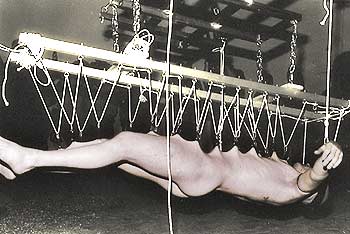
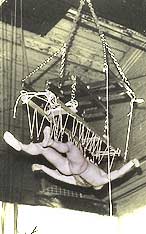
Left: Paul Stolz is pierced and rigged by Vaughn and Joey Wyman for a “flying” horizontal suspension. Right: Paul is zoomed up and down, back and forth, and rotated by Vaughn inside a huge warehouse space. I felt “electric” rain falling from his suspended body.I entered just as Paul was being lifted up in a horizontal, face-up suspension by multiple hooks. As he floated twenty feet above our heads, then gently moved about the cavernous space by Vaughn, it felt like “electric rain” was showering down on me from his suspended body. There were only a few friends present. The general feeling in the space was peaceful, tingling. Paul was on a trip and in an altered state. The suspension lasted for about an hour. In his own words, here is Paul’s account of his Sandbox suspension (from Body Play #14):
For as long as I can remember, I have wanted to fly. I have dreamt of finding myself between planes of reality. I thought that in that “space” I could get a clearer view, a better perspective of myself and its reality. Once that view has taught me something, I can continue on my quest for my dreams.Now I have found ways to slip into that alternate plane where possibilities are limitless. I call that place “Dreamland”. I got there mainly by using my physical self, my body. It usually requires some sort of pain or challenge.
I have wanted to do a full body suspension for four years. I thought the sensation against my body must be amazingly different than anything I could ever feel. Still, a full body suspension could be even more for me if I could fly — move around once I am off the ground. In fact, a non-mobile suspension seemed a little lacking to me. On March 22, 1996, I held a live performance in which I hung horizontally from a mobile 3-ton crane. The crane was driven by Vaughn (Body Manipulations body piercing studio) who also worked with Joey Wyman to put the hooks in and hang me. Vaughn drove me out above and throughout audience (about 25). I went way up to the ceiling, low to the ground. I was spun around, rocked back and forth and bounced up and down.
The combination of flying and the sensation of my skin pulling evenly through me was overwhelming. I had gotten to the most amazing version of “Dreamland”. The tension altered in intensity levels with the different movements we would try. I had found that, in fact, the sensations were completely adjustable based on far off the ground I was, what direction I was moving, or even the speed of the movement.
To me this was a very spiritual event but not a very religious one. I gained more contact with myself and my reality. I used my physical body as a tool to enter my psychological and spiritual self. Once I opened doors to this “Dreamland”. Other dreams found in day-to-day life have fallen into place. I find that as I continue exploring my reality in relations to “Dreamland”, my real life becomes more and more charmed.
Paul Stolz
So here are just a few examples and accounts of what has happened to contemporary seekers who have experienced suspensions. How about yours? There are so many experiences I wish to share with you that there will have to be a Part 3 and maybe even a Part 4 to this edition of Fakir Rants & Raves. See you next time for “Swimming With Dolphins” and more.
Yours for safe and enlightened body rites,

Fakir Musafar
fakir at bodyplay dot com
Fakir Musafar is the undisputed father of the Modern Primitives movement and through his work over the past 50 years with PFIQ, Gauntlet, Body Play, and more, he has been one of the key figures in bringing body modification out of the closet in an enlightened and aware fashion.For much more information on Fakir and the subjects discussed in this column, be sure to check out his website at www.bodyplay.com. While you’re there you should consider whipping out your PayPal account and getting yourself a signed copy of his amazing book, SPIRIT AND FLESH (now).
Copyright © 2004 BMEzine.com LLC Requests to republish must be confirmed in writing. For bibliographical purposes this article was first published May 8th, 2004 by BMEzine.com LLC in Tweed, Ontario, Canada.
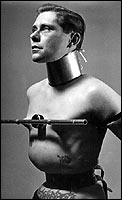
-
Go to prison, get a free tattoo. [The Publisher’s Ring]
Written by

Go to prison, get a free tattoo.
Ohhhh… Canada?
“Prisons are archaic, brutal, unregenerative, overcrowded hell holes where the inmates are treated like animals with absolutely not one humane thought given to what they are going to do once they are released.”– Jimmy Hoffa
-
The Great Nippulini Interview – Through the Modified Looking Glass
Written by

The Great Nippulini
“It’s not the load that breaks you down, it’s the way you carry it.”
– Lena Horne
Two of the main focuses of my life and work are body modification and sideshow. I spend time every day researching online for new information, going over the books in my personal library, and generally contemplating and updating my information base on both these subjects. Thus, it surprises when I find out I have somehow missed or overlooked a major player in either of these communities. Nippulini stands out in both, but still I somehow managed to miss him for a number of years.A little less than two years ago was the first time I ever heard of Nippulini — via online references and then his postings in an online sideshow discussion group. Since then I have gotten to meet and even share a stage with him at the 2ND annual Sideshow Gathering. He has made a serious dedication of himself to body modification and taken it to the stage with a rare passion.
Now, in his own words; The Great Nippulini!
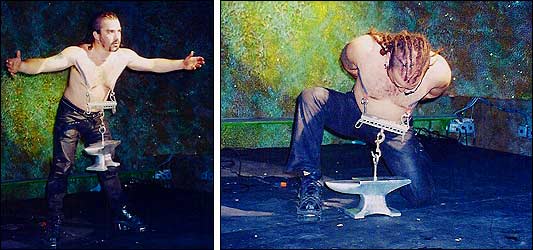


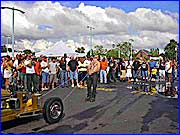
Be sure to check out Nippulini’s website at: http://www.greatnippulini.com/
 Erik Sprague
Erik Sprague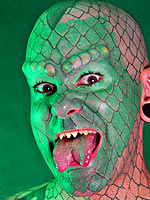
because the world NEEDS freaks…
Former doctoral candidate and philosophy degree holder Erik Sprague, the Lizardman (iam), is known around the world for his amazing transformation from man to lizard as well as his modern sideshow performance art. Need I say more?
Copyright © 2004 BMEzine.com LLC. Requests to republish must be confirmed in writing. For bibliographical purposes this article was first published April 26th, 2004 by BMEzine.com LLC in Toronto, Ontario, Canada.
-
Employment Discrimination: Be Careful What You Sue For [Guest Column]
Written by

Employment Discrimination:
Be Careful What You Sue For
By Marisa Kakoulas
On my first day of work at a stereotypical Wall Street law firm, four other lawyers took me for a fancy lunch to welcome me into the fold. All of us in dark suits and pasty white faces politely conversed about acceptable topics, all the while making sure we were using the right fork, until the moment when a man with neon hair, neck tattoos, and multiple facial piercings flashed before the window next to where we sat. The forks dropped. The man outside walked on. But his presence still lingered at our table.
“I don’t understand these freaks with all the tattoos and piercings,” started one at our table, and the discussion spiraled onwards towards burning the modified at the stake. Fortunately for me, my piercings and tattoos at the time were easily covered, otherwise I would’ve gotten singed.
…Or fired.
“A person can be fired because the company doesn’t like your shoes,” explains Robert D. Lipman, who manages the New York employment firm Lipman & Plesur, LLP, and is President of Interactive Employment Training, Inc.. I called Lipman to ask whether a person fired solely for having visible tattoos or piercings has any recourse under United States law. “We get a lot of calls like this,” he said. “People say ‘This is America. We should be able to do what we want.’ But I tell them that once you walk into a private employers workplace, your rights are limited.”
Limited, but not null.
Title VII of the US Civil Rights Act of 1964 says that a private company with more than fifteen employees cannot discriminate on the basis of religion, sex, race, color, or national origin. So company decisions to hire, fire, promote, shell out benefits or the key to the Executive Washroom must not be based on these “protected classifications.” To do so is illegal. Title VII is not the only law that protects Americans from job discrimination. Many state laws have extended protection against discrimination on the basis of sexual orientation, transgenderism, and even obesity. There’s also the federal Americans with Disabilities Act, Equal Pay Act, Age Discrimination in Employment Act, Immigration Reform and Control Act, Pregnancy Discrimination Act, and the National Labor Relations Act.
Despite all these Acts, the curtain falls for those judged on their body modifications, no matter how good the performance. That is, unless you can make a claim under one of these classifications.
RELIGIOUS DISCRIMINATION

While employees generally have more success claiming that dress codes infringe upon religious beliefs, for the tattooed and pierced, success is unlikely.
But isn’t body modification a choice like religion?
“Absolutely, yes. But the Constitution specifically guarantees religious protection,” says California and New York licensed attorney John Thomure, who has represented pro-bono petitioners before the US Supreme Court on constitutional protection claims, as well as having contributed to amicus briefs challenging South Carolina’s ban on tattooing. Heavily tattooed himself, Thomure says:
“Although we might grant great spiritual significance to our own body mods, my sense is a court would cast a very skeptical eye on it as a religious practice. And since outside of perhaps indigenous cultures [...] there is no history or antecedents for the “religion,” it would certainly look as though the creation of the body-mod religion was for the purpose in part of creating legal claims under a freedom of religion argument.”
Case in point: The Church of Body Modification [uscobm.com]. The Church states on its web site that its purpose is “for our modified society to harmoniously return to its spiritual roots that have been forgotten.” It adds that “we are not here to offer spirituality to you so much as we are here because of the spirituality that is already in all of us; often expressed through what we do to our bodies.”
This may not cut it as “a bonafide church.” Lipman mentions a California 9th Circuit Court of Appeals case where a vegan filed a discrimination suit under religious classification. The Court rejected the veganism as a religion claim, holding that vegan ethics do not constitute a religious creed because (among others) it is not a comprehensive belief system that addresses “fundamental and ultimate questions having to do with deep and imponderable matters.” Moreover, it noted that some people were vegan for health and not spiritual reasons.
It is very clear that the Church of Body Modification does not offer an answer to that ultimate question: “Why are we here?” And it does state on its site that many people choose to modify their bodies for non-spiritual reasons. Nevertheless, that did not stop one 27-year old woman from filing suit against Costco claiming that, as a member of the Church of Body Modification, her eyebrow piercing was an essential part of her faith. The case is still pending [questions forwarded to her went unanswered], and while unlikely, if it succeeds it could set major precedent in employment law.
Don’t get your hopes up. As Thomure points out, “Think of Mormons […] their practice of polyamory has not been given protection because of a conflict with a larger public policy.”
Public policy is key here because even if the Church of Body Modification could be deemed a bonafide religion, is it reasonable to ask a company like Costco to potentially lose customers who are put off by visible mods, especially more extreme ones? Jewish yarmulkes, beards, and religious garbs are acceptable. Can we claim full-body lizard scales in the same category? And while performer and PhD candidate Erik “The Lizardman” Sprague is probably smarter than all of us, should Costco be forced to have him ring up bulk items for Brooklyn grandmothers (assuming that’s a dream of Erik’s)?
I say no, unless lizard scale tattoos are allowed on female employees but not male, which brings us to…
SEX DISCRIMINATION

If an employer’s dress code significantly differentiates between men and women, without being based on social norms, or poses a greater burden on women, then it can be deemed discriminatory. So, for example, a dress code that allows earrings for women but not men could be considered discriminatory.
Imagine a case where a company allows its male employees to sport visible tattoos, but, after reading in the Philadelphia Daily News that tattooed women are sluts, the employer decides that it’s best for public relations that female workers remain pure and unblemished: To that, one can hear a resounding “Sue their ass!”
Keep in mind that the US courts have often held that anti-discrimination laws are not intended to hinder employers who set reasonable appearance standards fitting for their business. In 1998, the 11th Circuit Court of Appeals in Harper v. Blockbuster Entertainment upheld Blockbuster’s dress code that mandated male employees to cut their long hair, but not female employees.
Thus, even if there are different appearance standards for men and women relating to body mods, it’s still not an easy case to make out.
NATIONAL ORIGIN DISCRIMINATION

Employers cannot enact a dress code that treats certain employees unfairly because of their national origin unless it would result in undue hardship for the company. This national origin classification covers ancestry, language, accent, and culture, among others. So, for example, a Maori with a moko tattoo could have a claim under this provision as these facial tattoos are based on genealogy and tribal affiliations. Or an East Asian woman could fight to keep in her nose stud at work, claiming the cultural significance of facial adornment, such as in marriage ceremonies.
As a Greek-American, where my ancestors shunned tattooing except to mark the foreheads of criminals, it is improbable that I would fall under the national origin exception. In fact, it is my conservative Greek father who first voiced the claim that I must be crazy for having all my tattoos, which brings me to…
DISABILITY DISCRIMINATION

Tattoos as a disability? Is my ink a manifestation of some mental illness? Is it body dysmorphia? Narcissism? Was I not properly toilet trained?
It’s an unsettling argument with possible disturbing consequences.
Thomure agrees. He says that while the idea of body modification as a disability leaves a sour taste in his mouth, he adds that the claim “is not so far fetched.” He tells me to step back and ask “What do people tell you when you ask them ‘Why did you get heavily tattooed?’ Try drawing the real reasons out of people. Most will only answer superficially — ‘they’re pretty,’ ‘I like how I look’ — and hide the real reason.” In speaking with other heavily tattooed people he says that the motivations that are frequently mentioned are:
- It’s empowering and liberating — reclaiming of the body.
- Manifesting externally or physically strong sexual fetish in tattoos or piercing.
- A general sense that one was compelled to get so tattooed to make oneself complete.
It’s that compulsion that could very well be defined as an illness. However, according to Lipman, it’s probably not enough to get you covered under disability protection. Lipman says, “A disability has to impair a major life activity. Does having a tattoo stop you from eating or sleeping?”
No. But other body mods do — self-amputation, for one more extreme example. I’m not suggesting that those who practice body nullification are mentally ill. Hell, “my best friends are [self-amputees],” but it’s not my opinion that counts, but the State’s.
Yet another modified lawyer (yes, there are many of us) and tattooist, Devon, weighed in on the disability issue saying be careful what you sue for when discussing disability protection:
“If I choose to lop off a body part in the name of modification, should I then be entitled to ADA protection? Should I now be able to collect Social Security based on my ‘disability’? To me, the answer to that is a resounding “NO”!You start to hit governments or corporations in the wallet based on your modifications, and just see how free you are to get modified in the future.”
It’s a strong point. The backlash for filing all these body modification discrimination claims may be the banning of the modifications themselves, as in South Carolina and Oklahoma. Or, even more extreme, involuntary hospitalization.
BRINGING AN ACTION
Still, if you feel strongly that you’ve been wrongly discriminated against for your body mods, you may file a charge with your local Equal Employment Opportunity Commission [EEOC.GOV] office, which may be found online or by calling 1-800-669-4000. An EEOC charge must be filed within 180 days of the date of the disputed conduct.
Outside of the EEOC, a claim for breach of contract can be filed for those who have employment contracts, such as union workers or some executives. According to Lipman, there must be “just cause” to fire someone under an employment contract, unlike “at will” employment — Lipman says that most Americans fall under “at will” employment. He does not believe that a tattoo or piercing constitutes “just cause.”
Lipman also points out that government employees have greater protection than private employees because they not only fall under all those anti-discrimination acts, but they have constitutional protections as well. So, hypothetically, a government employee fired for having tattoos may have a free speech claim. Although I do have a hard time envisioning Condoleeza Rice with a moko testifying on behalf of her boss — the irony of it makes me snicker.
However, employment discrimination is no laughing matter, and legal action should be considered very carefully.
Also ask yourself, is discrimination so bad?
If I was fired from that law firm on my first day, it would have saved me over two years of suffering in an atmosphere that was not right for me. But something good did come out of it: After covering my body mods for a while and proving myself as a competent legal thinker, I eventually revealed that I indeed was “a tattooed and pierced freak.” I was not fired. In fact, just before I came to my own decision to leave the firm, two out of the four lawyers at that first lunch asked if I would let them accompany me when I got my next tattoo. I did and it changed their minds completely.
While it did not change my mind to stop practicing law, I still like to fantasize about opening my own firm to serve the body modification community and discriminate with abandon: The Non-Modified Need Not Apply.
In addition to the people mentioned in this article, I would like to especially thank Rebekah [iam:rebekah] for her invaluable help in case law research, ServMe [iam:ServMe] for his editing prowess, as well as the many other wonderful people of BME who raised important issues in the forums that helped shape this piece. I’d also like to thank Dan [calypsotattoo.com] for making me beautifully less employable. – Marisa Kakoulas
This article is not intended as legal advice. It is intended for only general information purposes. This article does not create any attorney-client relationship.

Marisa Kakoulas is a New York lawyer, writer, and muse of Daniel DiMattia of Calypso Tattoo, living in Liege, Belgium. She works undercover — or just covered up — as a corporate consultant: proof that tattoos and suits are not mutually exclusive. Her book “Tattoo Law”, an overview of US laws affecting the body modification community, is under way. IAM members can visit Marisa at iam:FREE.Copyright © 2004 Marisa Kakoulas. Online presentation copyright © 2004 BMEzine.com LLC. Requests to republish must be confirmed in writing. For bibliographical purposes this article was first published online April 5th, 2004 by BMEzine.com LLC in Toronto, Ontario, Canada.
-
The Raelians: Building Better Humans? [The Publisher’s Ring]
Written by

The Raelians: Building Better Humans?
“Cloning may be good and it may be bad. Probably it’s a bit of both. The question must not be greeted with reflex hysteria but decided quietly, soberly and on it’s own merits. We need less emotion and more thought.”
– Richard DawkinsI expected feedback on my last column, “What the modified can do for the mutants of the future”, which outlined how body modification could help prepare humanity for major morphological changes in generations to follow. However, I’d written it sort of tongue-in-cheek, so I was very surprised when I got a personal email from Rael — yes, that Rael. The email told me that it was important that we talk and urged me to call him at Clonaid in Geneva.
Sidebar: More info
The Raelian Message – Homepage
Clonaid – Corporate site
RAR/The Raelians – For skeptics
Rendering of the Raelian embassy, with Rael.
BME members are welcome to contact Rael c/o BME at
[email protected]. Any mail sent here for the next week will be forwarded directly to Rael’s private address. Please do not use this address after April 7th (2004) as it will cease forwarding at that point.For those of you who don’t know, the Raelians are an organization — some would say “alien sex cult” — that believes in scientific creationism — that “aliens” came to this planet and manipulated primitive DNA in order to create humans. In 1973, French journalist Claude Vorilhon (who now goes by “Rael”) was contacted by a small alien being who told him that their race, the Elohim (“those who came from the sky”, as described in Genesis), had been the ones who had created human life on Earth, and that mankind had mistaken them for gods and built religions around them. Because of the moon landing, they felt we were mature enough to hear the truth, and dictated the Raelian message.
-
What can pierced people do for the mutants of the future? [The Publisher’s Ring]
Written by

What can pierced people do
for the mutants of the future?
“Humans are ends in themselves, but that does not rule out the use of oneself as a tool to achieve oneself. In fact, one of the best ways of preventing humans of being used as means rather than ends is to give them the freedom to change and grow.”
– Anders Sandberg
From a talk at TransVision 2001, Berlin
Tori Swanson, 12, wanted a nostril piercing. Her parents both supported her in this wish, and, wanting to ensure that it was a safe and positive experience,
Want to give your feedback on the abuse of power going on? Here’s some contact addresses for you. Sadly this is far from a unique incident, but we have to tackle them one at a time. Please let them know what you think.Dr. Judy F. Pippen, Principal at Bailey Middle School
[email protected] or 850-479-6479
Jim Paul and Norm Ross, Superintendent’s Office
850-469-6131 voice, 850-469-6479 fax
Norm Ross told me that feedback could be faxed to this number and it would be passed on to the appropriate committee.Dr. Allen Scott,
Director of Secondary Education[email protected]
Scott is currently chairing the committee that is setting the dress codes for secondary students.Her father took her to a professional studio where he signed the release forms and she was pierced. However, when she returned to Jim C. Bailey Middle School in Pensacola, Florida, the principal, Dr. Judy F. Pippen, suspended her and told her she would stay suspended as long as the jewelry was in her face. The school argued that Tori’s nostril piercing was so destructive to the other students’ ability to learn that they had no choice but to expel her.
It took a bit of bouncing around — no one wanted to take responsibility for the act or even explain it at first — but eventually I managed to talk to Norm Ross at the superintendent’s office who confirmed the story’s veracity (I’ve put various contact addresses in the above/right sidebar if you’d like to comment after you’ve read this).
BME: I don’t entirely understand why she was suspended. What exactly was the issue?
ROSS: The principal must have thought it was a distraction.BME: So that really was the only reason? Not health or safety?ROSS: No, it was a distraction.BME: Does the school have other problems with other students that are a distraction because of the way they look?ROSS: Of course.BME: What about minority students? Will you be getting rid of them as well?ROSS: You’re reaching with that.BME: Am I? How many minority students do you know that have been in fights because of their skin color? Do you know of students with piercings being such nexuses for problems? Am I really reaching, or am I just being too objective?I may have been comparing apples and oranges, but I wasn’t “reaching”. Suggesting that one student becoming so mentally unfocused that they are unable to learn around a student with a nose piercing is the pierced student’s fault is ludicrous. Of course, when the victim is a minority, even a self-imposed minority, they are often changed from victim to culprit when the mainstream is the one telling the story. Norm Ross then switched the subject, asking me, “You know, if you really want the real story, you should talk to Tori. She doesn’t even want this piercing.”
BME: What? Are you saying that the parents forced her to get a nostril piercing?
-
Elvish Spoken Here: BME/News
Written by


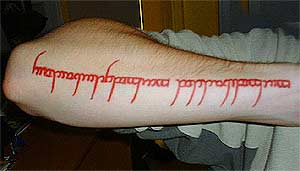
You may be wondering why BME is running an article on linguistics that barely mentions tattoos. Well, since BME was started in 1994 I’ve been getting photos of tattoos in the Elvish languages invented by JRR Tolkein, and my own now ancient first professionally done tattoo was in Quenya script. Now, with the overwhelming success of the movies, coupled with the stars of the films almost all going out and getting Tengwar tattoos themselves, we thought it might be fun to learn a little more.– ShannonElvish Spoken Here
by Frederick G. Volpicelli, CCPIn 1931, Tolkien wrote an essay about the somewhat peculiar hobby of devising private languages. He called it “A Secret Vice”. But in Tolkien’s case, the “vice” can hardly be called secret anymore.
What, really, is going on inside the head of a man who all his life is toying with enormous linguistic constructions, entire languages that have never existed outside his own notes? One thing that was important to Tolkien was that languages should be beautiful. Their sound should be pleasing. Tolkien tasted languages, and his taste was finely tuned. Latin, Spanish and Gothic were pleasing. Greek was great. Italian was wonderful. But French, often hailed as a beautiful language, gave him little pleasure, but heaven itself was called Welsh.
He stated that the Elvish tongues were “intended to be definitely of a European kind in style and structure and to be specially pleasant.”
While World War I was still raging, Tolkien’s linguistic constructions definitely became elvish languages. In 1916 he wrote that he had been working on his “nonsense fairy language — to its improvement. I often long to work at it and don’t let myself ’cause though I love it so it does seem such a mad hobby!” Mad or not, he was to give in to his longing and keep working on this hobby throughout his life.
Exactly at this point, in 1916, while Tolkien was in the hospital having survived the Battle of Somme, the very first parts of his “mythology for England” were written — fragments of what would one day become the Silmarillion. At the same time, he wrote his first Elvish word-lists. One thing triggered the other: “The making of language and mythology are related functions,” he observed in A Secret Vice. “Your language construction will breed a mythology” Or again in a letter written many years later, shortly after the publication of Lord of the Rings: “The invention of languages is the foundation. The ‘stories’ were made rather to provide a world for the languages than the reverse. To me a name comes first and the story follows. Lord of the Rings is to me…largely an essay in ‘linguistic aesthetic’, as I sometimes say to people who ask me ‘what is it all about?’” Few people took this explanation seriously. “Nobody believes me when I say that my long book is an attempt to create a world in which a form of language agreeable to my personal aesthetic might seem real,” Tolkien complained. “But it is true.”
The years passed by and the stories of the Silmarillion evolved, but it seems that the relevance of the original dictionaries soon dwindled: Frequent revisions inevitably rendered them obsolete. In the second half of the thirties, however, Tolkien made a list of some seven hundred Primitive Elvish “stems” and some of their derivatives in later languages. It was apparently this list, the so-called Etymologies, he was referring to when he started to write The Lord of the Rings.
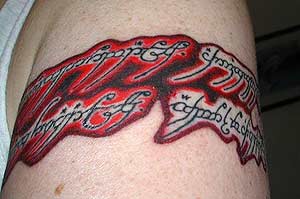
This brings us over to the technique used by Tolkien in devising his linguistic creations. How was it done? Christopher Tolkien, his son, describes his father’s strategy as a language-maker in one formidable sentence: “He did not, after all, ‘invent’ new words and names arbitrarily: in principle, he devised from within the historical structure, proceeding from the ‘bases’ or primitive stems, adding suffix or prefix or forming compounds, deciding (or, as he would have said, ‘finding out’) when the word came into the language, following it through the regular changes in form that it would thus have undergone, and observing the possibilities of formal or semantic influence from other words in the course of its history.” The result: “Such a word would then exist for him, and he would know it.”
Throughout his life he kept revising, revising, revising. In the words of his son, “The linguistic histories were…invented by an inventor, who was free to change these histories as he was free to change the story of the world in which they took place, and he did so abundantly… Moreover, the alterations in the history were not confined to features of ‘interior’ linguistic development: the ‘exterior’ conception of the languages and their relations underwent change, even profound change.”
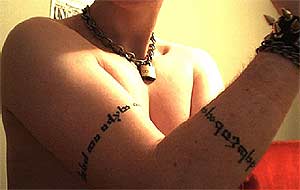
Sindarin is a good example of changed ideas about the outer history of the languages. The scenario set out in the appendices to Lord of the Rings is that this is the language of the Sindar, the Grey-elves — the Elves that came to Beleriand from Cuiviénen, but did not go over the sea to Valinor. But in Tolkien’s pre-Lord of the Rings notes, Sindarin is called Noldorin, and before that Gnomish, for this was the language of the Noldor or “Gnomes”, the “Wise Elves”. It was developed in Valinor, while Quenya in the former scenario was the language of the Lindar, the first of the three clans of the Eldar (to complicate matters even further, the Lindar were later renamed and became the Vanyar, while Lindar became a name of the third clan, the Teleri). But then Tolkien must have realized that the Elves, immortal and all, would hardly develop radically different languages when they lived side by side in Valinor. So according to the revised scenario, both the Vanyar and the Noldor spoke Quenya with just minor dialectal differences, while the “Noldorin” language that Tolkien had already made was simply re-christened Sindarin, transferred from Valinor to Middle-earth and relocated to the mouths of the Grey-elves there. It was, of course, far more plausible that they had developed a language very different from Quenya, having been separated from their kin in Valinor for thousands of years. Christopher Tolkien comments, “So far-reaching was this reformation that the pre-existent linguistic structures themselves were moved into new historical relations and given new names”. The various “flavors” of Elvish in body face above will later connect directly to various writing styles Tolkien invented. It is interesting to note that as he invented these languages and allowed them to age and morph together he continually left the original constructs alone. His language, therefore, has dialects spanning hundreds of years.
How, then, do Tolkien’s languages fare today, when a quarter of a century has passed? Some of us have embarked on the study of Elvish, perhaps with somewhat the same attitude as people enjoying a well-made crossword puzzle: The very fact that no real Elvish grammars written by Tolkien have been published makes it a fascinating challenge to “break the code”. Many simply enjoy the Elvish languages as one might enjoy music, as elaborate and (according to the taste of many) gloriously successful experiments in euphony. During my 40-year study I never actually tried to pronounce Elvish. It wasn’t until the movies were released that the music of Tolkien’s language came through for me. For those of you who are interested you can find an online Elvish Pronunciation Guide [dcs.ed.ac.uk].
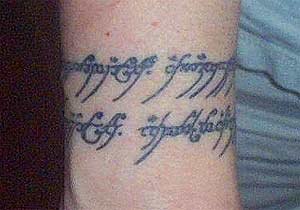
My own story started 40 years ago. I personally made a serious study of Elvish from 1964-1968 while attending the Courant Institute of Mathematical Sciences at New York University. It was a very complex game that allowed me to get lost in the Appendices of Lord of the Rings while surviving Calculus and Physics. In 1966 I switched from pure math to the then very new study of computers and proceeded to absorb my first computer language, Fortran II. Quickly added was Fortran IV (later to morph into Fortran 77 with BASIC as a subset), COBOL, SNOBOL, ALGOL, LISP, PL/1, and, of course, the very elemental assembly language (first for the Control Data 6600 mainframe, then 6502 processors). I don’t think I realized it then, but the study of elvish constructs prepared me for my initial forays into computer language. Tolkien’s language was perfectly created, few holes, strict rules, and logically bound. Just like computer languages (which didn’t exist when Tolkien invented Elvish).
To further my ability to deal with Elvish I took a college course in phonetics. (My NYU advisor had fits with me. I was a math major, taking a minor in English Literature, with Greek and Roman mythology, art history, and phonetics as electives). With a solid background in phonetics I was able to transcribe English into Elvish. You first break down the English into pure phonetic constructs. There is a whole separate compendium of characters to describe how words are actually pronounced (far past what’s in the dictionary). The beauty of phonetics is that the same constructs apply basically to all languages. Tolkien used these sale constructs to build his elvish language. There are direct correlations between the constructs and the written elvish letters.
So with a lot of study I was able to convert words into elvish script. Now back then, of course, it was all done by hand and mind. A long tedious process. I used to hand letter custom t-shirts for people as a way to pay the bills (somewhere along the way I took up the study of calligraphy). Fueled with copious amounts of drugs I got through college, picked up a Master’s degree in Computer Science, and started teaching. I was a High school math teacher, Assistant Professor of Computer Science, Visiting Lecturer, and now a network and Internet consultant. Along this 35-year odyssey, computers developed, and fonts came into being (it may not seem so, but True Type computer fonts are a very recent development).
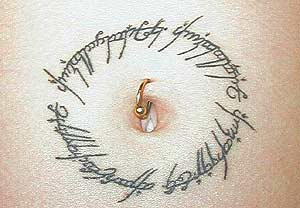
Turns out that there a lot of other fanatics like myself out there! Computer tools have been developed to transcribe the root English to phonetic constructs. True Type Elvish Fonts are developed. Photoshop provides the art space. Now I can transcribe rather quickly. Late last year, with the movies being so popular, I offered BME members a free transcription of anything they want. I create a hi-res JPG in one of the many elvish fonts available.
The artical title at the top of the page, “ELVISH SPOKEN HERE,” is transcribed just above it into the Tengwar cursive form of Elvish. The intermediate phonetic construct is written “jRrdT 8qzY5$ 96RO”. The construct is then converted to the correct Elvish font. The form of Elvish as created by Tolkein is known as Tengwar. This is a family of written languages belonging to the elves. The common style is called Sindarin and is the language of the Grey-Elves (i.e. Rivendell), another style is Quenya belonging to the “High-Elves”. There are numerous written variations, with some in the cursive style above and some in a more Runic style (as is the Cirth language of the Dwarves).
Frederick G. Volpicelli, CCP
What follows is the phrase “Elvish Spoken Here” transcribed into Tengwar in different styles.
Sindarin
Basic
Sindarin
Type 1
Sindarin
Type 2
Sindarin
Cursive
Quenya
Basic
Quenya
Type 1
Quenya
Type 2
Noldor
Basic
Noldor
Type 1
Noldor
Type 2
Note: The Tolkien backstory detailed above is largely paraphrased from articles at the Elvish Linguistic Fellowship, the Tolkien Society, and the introduction to “Tolkien’s Not-So-Secret Vice” by Helge Kåre Fauskanger.
Free for IAM Members: Elvish Transcription Service. Send me the text you want transcribed into one of many styles of Elvish and I’ll email you an image.Details can be found at www.mikron.com/bme/
Frederick G. Volpicelli (iam:misterV)
Article by Frederick G. Volpicelli. Copyright © 2004 BMEzine.com LLC. Permission is granted to reprint this article in its entirety as long as credit is retained and usage is non-commercial. Requests to publish edited or shortened versions must be confirmed in writing. For bibliographical purposes this article was first published March 25th, 2004 by BMEzine.com LLC in Toronto, Ontario, Canada.

-
Bill Heath: American Traitor [The Publisher’s Ring]
Written by

Bill Heath: American Traitor
“The only freedom which deserves the name, is that of pursuing our own good in our own way, so long as we do not attempt to deprive others of theirs, or impede their efforts to obtain it.”– John Stuart Mill, “On Liberty” (1859)
Note: If you’re reading this “live” as this incident is playing out, you can visit the website of The Piercing Experience, a Georgia studio (and one of the nation’s best) that is actively following this case and posting to-the-minute info.
Thanks to Republican representative Bill Heath, a man who many believe had part of his penis mutilated in a bizarre religious ritual*, Georgia (as in the US state, not the communist republic bordering Turkey) is getting ready to pass a new law banning genital piercing for consenting adult women. This law would dictate mandatory two year prison sentences for any piercer that does these piercings, with a maximum punishment of twenty years in state prison simply for doing a hood piercing. Shockingly, this law unanimously passed the House (160-0!) and is now seeking approval from the Senate before being signed by the Governor.
* It’s called circumcision, silly… but you have to admit that chopping off a part of a baby’s penis to appease your God is a little more messed up than adult women enjoying sex.Bill Heath sponsored the law as an amendment to an existing FGM bill, slipping it into an unrelated bill at the last moment after someone mentioned to him that female genital piercing existed — “What?” the moron replied (“slack-jawed” were the words of the Associated Press reporter). He continued, “I’ve never seen such a thing… I, uh, I wouldn’t approve of anyone doing it. I don’t think that’s an appropriate thing to be doing.” Later, after jotting down a quick anti-woman, anti-freedom rant, he explained, “[I am trying to] make illegal the voluntary piercing of female genitals for decorative purposes.”
This bill is fundamentally wrong. Honestly, it’s so wrong it’s insane. You know, I’ve seen politicians do some stupid things, but I’m still always amazed when someone’s hatred and closed-mindedness can so void any semblance of intelligence and leave them as nothing more than a hollering buffoon. Let’s take a closer look.
There has been no public or private debate on the subject.
Bill Heath wasn’t elected to introduce this ban — he’s not acting on his constituent’s wishes. He introduced it on a whim, after hearing about a subject he knew nothing about. I’ll ignore spending much time asking you whether you really want a politician that rashly forces through law, without consulting experts, the public, or anything other than his bigotry. Even if you agree with his conclusion about female genital piercing, his way of reaching and enacting it spits in the face of liberty.
The House never debated this amendment, and neither did the public — this was forced through so quickly that the media didn’t even report on it until the House had already approved the law. That’s just not how democracy is supposed to work!
This bill is fundamentally sexist and anti-woman.
A bill that bans a unisex activity (since both genders enjoy genital piercings) for only women is sexist. Remember, this bill only bans genital piercings on women — men are still permitted to have them. Saying that women can’t have piercings says that women don’t have a right to their bodies, since every woman I know with genital piercings got them consensually, and usually totally independently of anyone else. The supplemental argument — one that’s currently playing out in the California courts with Todd Bertrang — is that women are so weak that they can’t stop piercers forcing modifications on them, an equally insulting claim.
I don’t know if Bill Heath has fundamental shortcomings in his manhood that make him so terrified of female sexuality that he’s trying to ban it at all costs, but it’s not his place and it’s not his right. Especially given how many women use genital piercings as a way of claiming their own bodies back from male-dominated culture, Bill Heath’s attempt to violate women by taking away that right to their bodies is despicable. His attempt to introduce such legislation via a rider on a bill essentially designed to protect women makes it even more sickening…
This bill ignores thirty years of culture and research.
Genital piercing has been popular and at least partially above-board in Georgia for about thirty years, and publicly accessible commercial body piercing studios have been doing genital piercings for a decade and a half in Georgia. Tens of thousands of women in Georgia have genital piercings and are very happy with them, and complications are virtually unheard of (it’s not as if this is tongue splitting, or a procedure with real risks). There have been no studies suggesting that female genital piercings are anything except healthy, stimulating, and extremely positive.
This bill is unfair to business.
This bill tells companies with a decade and a half of successful and appreciated history in the community that, without space for debate or negotiation, they have to cease operating or face prison time. Government has no right to arbitrarily put people out of businesses they’ve held for most of their lives simply because some small-minded legislator decides to scribe his hate-filled whims onto a larger bill.
This bill violates citizen’s privacy and overextends government’s reach.
The simple fact is that this is none of the government’s business. We’re not talking about minors. We’re not talking about danger. We’re talking about a safe, positive, and private activity between consenting adults. This isn’t like drugs or guns or any of the other hot topics politically — there are no societal risks or dangerous cultural side-effects from allowing people to have happy lives. The government simply has no right to intrude on people’s private lives and tell them how to enjoy and decorate their genitals.
This bill does nothing to protect the safety of the public. It is nothing more than an attempt to enforce one specific moral code, and, even if Bill Heath is right and women with genital piercings are an affront to God, it’s not government’s place to write laws about it. Henry George said it far better than I could — “It is not the business of government to make men virtuous or religious, or to preserve the fool from the consequences of his own folly. Government should be repressive no further than is necessary to secure liberty by protecting the equal rights of each from aggression on the part of others, and the moment governmental prohibitions extend beyond this line they are in danger of defeating the very ends they are intended to serve.”
This bill is fundamentally unamerican.
This bill takes the shockingly backwards view of a tiny minority and attempts to force it on the majority. America, at least in theory, is a place where you can be whoever you want to be and do whatever you want to do, as long as you’re not hurting anyone else. Your own thing in your own time. America isn’t a country that passes laws putting people in prison for having the wrong political views. It’s not a country that tells people what they have to believe. It’s not a country that would send people to prison over body piercings for longer than they’d get for most armed robberies… or is it quickly becoming that, thanks to traitors like Bill Heath?
In the words of Thomas Jefferson, “I would rather be exposed to the inconveniences attending too much liberty than to those attending too small a degree of it.”
So let’s be real clear on this:
Bill Heath isn’t just a moron and a bigot. He’s also a traitor.Bill Heath is involved in an active conspiracy to strip American citizens of their fundamental civil rights and freedoms. Mask it in moralism all you want, but you can’t get rid of that core truth. Even if you think female genital piercing is sick and perverted, are you comfortable living in a country where the government is so controlling and invasive that they even tell you how to have sex?
Bill Heath thinks that’s what America should become. You can reach the treasonous bastard via email at [email protected] or via his homepage at billheath.net. In addition, here are three more direct methods:
HOME OFFICE CHURCH
2225 Cashtown Road
Bremen, Geogia 30110
770-537-5234
770-537-6383 (fax)(his wife Susan will answer — she probably does not have genital piercings)
Suite 501, Legislative Office Building
18 Capitol Square
Atlanta, Georgia 30334
404-656-0177(his secretary Pat Alexander will probably answer — chance of genital piercings also extremely low)
Abilene Baptist Church3917 Washington Road
Martinez, GA 30907
706-869-1774Be sure to let him know what you think — in the form of words though, not the bullets he deserves. Or, if you think you can contain your rage better than me and you think you can get through, try and explain to him or his wife why genital piercing is important to you and why you hope he’ll recant his crimes against humanity.

Shannon Larratt
BMEzine.comPS. You can also contact Governor Sonny Perdue himself at 404-656-1776 or online by clicking here. In addition, here’s a list of all the email addresses for Georgia’s Senators (who have to sign off on the bill next, although since it’s obvious that this ludicrous law would never stand up to a challenge in court, I’m hoping they’ll have the sense to remove it) — you can paste list this into your email and urge them to vote to remove Bill Heath’s anti-piercing amendment to House Bill 1477 (Senate Bill 418):
[email protected], [email protected], [email protected], [email protected], [email protected], [email protected], [email protected], [email protected], [email protected], [email protected], [email protected], [email protected], [email protected], [email protected], [email protected], [email protected], [email protected], [email protected], [email protected], [email protected], [email protected], [email protected], [email protected], [email protected], [email protected], [email protected], [email protected], [email protected], [email protected], [email protected], [email protected], [email protected], [email protected], [email protected], [email protected], [email protected], [email protected], [email protected], [email protected], [email protected], [email protected], [email protected], [email protected], [email protected], [email protected], [email protected], [email protected], [email protected], [email protected], [email protected], [email protected], [email protected], [email protected], [email protected], [email protected], [email protected]
-
Dick Zigun Interview – Through the Modified Looking Glass
Written by

NOTE: If you’re reading this on Wednesday, March 17th, then you can
watch The Lizardman on TechTV tonight when he’s the guest on UNSCREWED!
Dick Zigun
“Whatever you do, do it with all your might. Work at it, early and late, in season and out of season, not leaving a stone unturned, and never deferring for a single hour that which can be done just as well now.”
– P.T. Barnum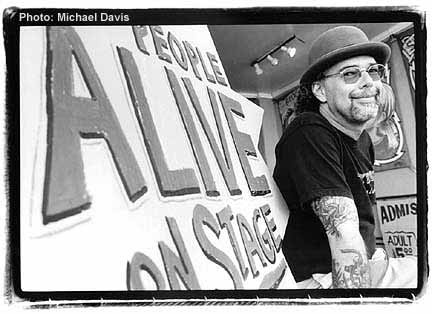
Dick Zigun is the man. No, not that man, not the one that’s been holding you down all these years. He’s the good kind. Dick is the driving, some might say whip-cracking, force that helps keeps sideshow alive at Coney Island. He is an ever present icon at Sideshows by the Seashore overseeing daily operations and even taking part in the cast when needed as a talker. If you’ve caught any of the many sideshow documentaries and programs that have often graced basic cable networks such as Discovery and TLC in the last half dozen years then you have likely seen Dick acting as spokesman for Coney Island — and he is eminently qualified to do so.
I first met Dick Zigun when I did a guest appearance at Coney Island in 2002. And, at the risk of tarnishing his otherwise gruff reputation, I have to say that what impressed me most was how incredibly welcome he made me feel. Talking with Dick and working with his cast, I had never before felt so good and reassured about myself and the path I had chosen.
But, I don’t want to risk ruining his reputation any further, so let’s meet Dick Zigun!
THE LIZARDMAN: Beginning with the usual interview formalities…DICK ZIGUN: I am founder and Artistic Director of Coney Island, USA, a non-profit arts organization dating from 1980 whose purpose “is to defend the honor of American popular culture through innovative performances and exhibitions.”I was born May 11, 1953 in Bridgeport, CT. PT Barnum was mayor, developer, and patron saint of Bridgeport. He built his houses there and had the winter headquarters of the circus there. He bought up the shorefront (which was the front yard of his second house) and left that property and others to the city for parks. There is a big beach with a statue of Barnum. To grow up in Bridgeport is to think that elephants and midgets are patriotic and all-American.
During the big Barnum Festival each summer (month long, largest 4th of July parade in USA during the 1950’s, car show, air show, 5th graders impersonating midgets, etc.) the local paper is full of biographical info on Barnum and Tom Thumb, who was born and lived a few doors from my grammar school. I was a Barnum scholar before I was a teenager.
THE LIZARDMAN: You have an impressive pedigree academically and professionally (Bennington, Yale) and many notable connections in the art world — so why sideshow?DICK ZIGUN: 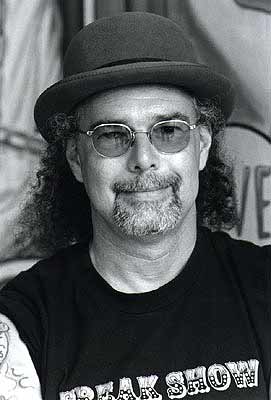
I was a scholarship student for a BA at Bennington College (when it was the most expensive college in the world in the early 70’s) and again a scholarship student for the 3 year MFA program at Yale School of Drama. Back then there were no books and no classes on sideshows or vaudeville or burlesque… not at my schools and not at any schools.As a Bridgeport guy out to defend American theatrical traditions I was an oddball, a rebel, and a pioneer. I was writing plays about ventriloquists wanting to kill Thomas Edison — things like that. Right out of Yale School of Drama I was produced in the regional theater movement I had been trained for but not happy typecast as an edgy experimental playwright doomed forever to producing new plays in regional theater second spaces for the hoity-toity blue haired ladies.
In 1979 I was having a play produced at the Mark Taper Forum in LA… grooving on the beach and thinking that LA was the capital of America… but set on living in New York City which is the capital of the world and the only place someone serious about theater can earn a living. Another play being produced at the same time in LA was KID TWIST by Len Jenkin about the Murder Inc. stool pigeon thrown out the hotel window in Coney Island. I went back again and again to see the play and Coney Island intellectually struck me as a way to live the beach lifestyle in NYC.
Then I was visiting the Santa Monica pier and epiphany struck when I saw an arcade building for rent. I vowed to go back to Coney Island and check out loft space. One thing lead to another and by 1985 I opened a theater/arts center on the Boardwalk called Sideshows by the Seashore. Sideshows are the most indigenous theatrical tradition in my chosen neighborhood so it was only natural to create a program where we would be the only place left in America to keep alive the ten-in-one.
THE LIZARDMAN: You are noticeably tattooed (your sleeves) with work by notable artists – tell us about your tattoo work and the artists responsible.DICK ZIGUN: Running an arts center has given me the opportunity to bring a lot of American underground culture into the mainstream by virtue of being a known arts center in NYC that sends out press releases, puts on public advertised shows, and organizes artists to present things. We not only pioneered the new sideshow movement but also helped to create the new burlesque movement, and within NYC (which tattooing was illegal in and no one was producing an annual tattoo show) helped to bring tattoos out of the underground.Our first tattoo/motorcycle show was in 1986. I was producing a tattoo show, hanging out with tattooed people, making money off of tattooed people, and was good friends with Michael Wilson… I thought long and hard for ten years about myself and whether I would spend my life employing freaky people but remaining a standoffish academic type. So in 1996, after ten years of over-intellectualizing, I came up with this: four limbs equals: earth, water, fire, air.
I got my first tattoo, on stage, in the street, in front of the police captain when tattooing was still illegal in NYC and everyone could hear me scream. Spider Webb tattooed my right arm which is “water”. Camille Cline, spider’s protégé, did my left arm which is air. Dragonfly, another spider protégé, is working on my right leg which is fire. That’s as far as I’ve gotten.
THE LIZARDMAN: At what point did you begin getting tattooed in relation to your association with sideshow?DICK ZIGUN: Michael Wilson, with his debut in Modern Primitives, had a lot to do with introducing post-modern tattoos and piercings to America. When Michael first worked here no one since Jack Dracula had publicly exhibited a tattoo face… some 20-25 years. It was a big deal and since pierced tongues were also unusual in the 1980’s it was a big deal when Michael would hammer a nail thru his tongue. Now every suburban teenage girl in American has a pierced tongue.When I first came to Coney Island I was an outsider artist type and my education and non-Brooklyn accent enamored me to the locals as a spokesman for Coney. It would have been difficult back then if I was heavily tattooed but now I’ve become some kind of Coney Island institution and as long as I stay alive and articulate it doesn’t matter much what I do… well, maybe it would matter if I tattooed my face.
THE LIZARDMAN: You have known and worked with a number of people who were heavily tattooed (including probably more facially tattooed modern performers than anyone else). Has this changed your perception of tattooing, or facial tattooing? Ever considered going that route yourself?DICK ZIGUN: Knowing and loving and respecting so many heavily tattooed people helped me accept the idea of inking myself. I can see myself with a total bodysuit but not facial or hand tattoos. I am an old-style kind of guy. My job is to be the producer and director and spokesman. I am not one of the performers. Since I am always hanging around the place my tattooed sleeves help in that I am another freaky looking staff person. But as a spokesman it is best that the audience more or less identify with me as one of them and not one of the extreme freaks.THE LIZARDMAN: Do you think that sideshow has helped or hindered the popular view of heavily modified people (such as those with facial tattooing)?DICK ZIGUN: Without question the sideshow movement has helped the popular view of heavily modified people. A few decades ago a Michael Wilson or Lizardman or Enigma would have been stoned walking down the average small town American street… now you all are famous TV celebrities.THE LIZARDMAN: What societal role do you see sideshow playing in the future? What does it provide?DICK ZIGUN: Sideshows have reintegrated themselves into American culture. You see sideshow influence in rock videos, in advertising, in fashion. I am proud to have a role in moving sideshow culture from the margins back into the mainstream, where it belongs. America used to have an inferiority complex about its own culture: sideshows, burlesque, vaudeville.We used to be embarrassed not proud of our populist culture. Everything used to be Eurocentric and that was boring and elitist. Artists especially are now free to use American culture as history and influence without freaking out their professors or getting kicked out of school, galleries, and museums. Nevertheless, not I nor Jim Rose nor the Bindlestiffs have made big money out of producing sideshows. It only goes so far.
I’d like to see it go farther and I’d like to see sideshows make more money — especially since we need to institutionalize the arts center in Coney Island, now that Coney Island is developing fast and taking off. We are renters and not owners and our lease in up in two years. We need to fund this place and the history that has taken place here since the 1980’s or else we will lose it.
THE LIZARDMAN: Coney Island now offers a sideshow school — tell us about that.DICK ZIGUN: Of course there is a lot of interest in sideshow acts by a new generation of circus idiots for the 21st century… and there is a lot of bad info out there in books and on websites about how to learn and master the sideshow arts which are dangerous!!! So since we are a non-profit educational institution we decided we would be the very first school which taught the arts the right way.It helps us earn money for our programs and it helps eager sideshow amateurs learn how to stay out of the hospital.
THE LIZARDMAN: With over two decades experience you have been working the sideshow longer than many of its current fans and hopeful future stars have been alive. What would you suggest they consider or do before taking their first steps or preparatory measures before beginning training at the school or elsewhere?DICK ZIGUN: I am amazed how casually some people tattoo their faces or do extreme body modification these days. Used to be that someone would get a tattooed bodysuit first and then consider the face but these days some kids start with the face.Frankly, although a lot of brilliant committed people get facial tattoos, a lot of others are “no future” crusty heroin junky types who just don’t care about next year or even what tomorrow brings. Fine if that’s your chosen lifestyle, fine but sad… but if you’re gonna be a professional in a sideshow then you need to show up for work on time every day and act sober — junkies don’t get jobs on payroll at Sideshows by the Seashore.
THE LIZARDMAN: Given your experiences would you recommend others attempt a similar path?DICK ZIGUN: If it is a “labor of love” and you just gotta do it, then sure, I’ll not only recommend it but be your mentor and give you advice (up to a point; don’t need more competitors). Ain’t no one gonna get rich doing sideshows and the trials and tribulations will mess with your family life and love life and make your life hard but very, very interesting.THE LIZARDMAN: What does the word ‘freak’ mean to you?DICK ZIGUN: Freak used to be a pejorative, a bad word. Now it’s a badge of honor. People wanna be a freak. Freaks have freedom; freaks are not like everyone else. Freaks are cool.THE LIZARDMAN: Is there any act that you have always wanted for the show but never got?DICK ZIGUN: Siamese Twins. A perfectly proportioned 3 foot high midget. A 9 foot tall giant. The real missing link. Hell, even a sideshow celeb like the Lizardman working for me at minimum wage for an entire summer. I better keep dreaming…THE LIZARDMAN: Say whatever you want.DICK ZIGUN:
 Erik Sprague
Erik Sprague
because the world NEEDS freaks…
Former doctoral candidate and philosophy degree holder Erik Sprague, the Lizardman (iam), is known around the world for his amazing transformation from man to lizard as well as his modern sideshow performance art. Need I say more?
Copyright © 2004 BMEzine.com LLC. Requests to republish must be confirmed in writing. For bibliographical purposes this article was first published March 17th, 2004 by BMEzine.com LLC in Toronto, Ontario, Canada.

